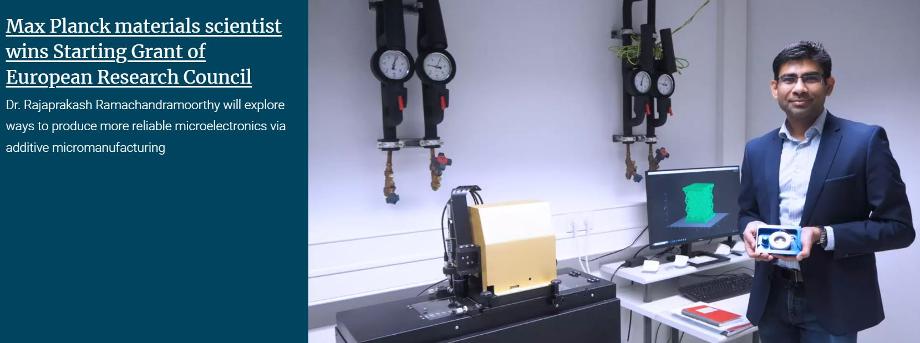Max Planck Scientist to Conduct MEMS Research with Exaddon μAM Technology

Image source: MPIE
Dr. Rajaprakash Ramachandramoorthy has been awarded a prestigious European Research Council (ERC) starting grant for research into fabricating and testing 3D metal microarchitectures with additive micromanufacturing (µAM).
Pictured above with the CERES system purchased by Max-Planck-Institut für Eisenforschung (MPIE) in 2022, Dr. Ramachandramoorthy and his team will be using Exaddon's technology for microelectromechanical systems (MEMS) applications:
"I will use additive micromanufacturing to print 3D metallic architectures with micron and nanoscale resolution. This fabrication method will enlarge the design freedom for microelectronic applications, among others. Moreover, the fabrication is based on localized electrodeposition, making it highly versatile and enables printing with a variety of different metals such as copper, gold, cobalt, nickel, silver".
The use of Exaddon's technology helps to circumvent the current manufacturing limits facing the MEMS industry, the importance of which is enormous. MEMS are essential in many of the devices which are a critical part of modern life, such as smartphones, computers, medical sensors, and cars. Up to a certain size range, lithography processes are typically employed to fabricate structures for microelectronic applications. However, current fabrication methods have reached a limit, and the use of Exaddon's microscale additive manufacturing technology offers new possibilities.
According to Dr. Ramachandramoorthy “I think in the future, a combination of both techniques is ideal. UV lithography will remain the method of choice when it comes to fabricating silicon based 2.5D microarchitectures. Whereas additive micromanufacturing becomes interesting whenever 3D microarchitectures with a wider choice of metals is needed or the incorporation of liquids is targeted.”
The importance of this work has been recognized in the awarding of an ERC starting grant of €1.5 million over five years.
Max Planck Advancing MEMS Research with the Exaddon CERES System